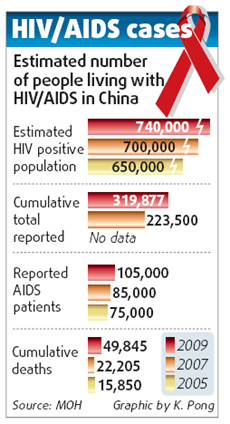HIV/AIDS hits 740,000 nationwide
The number of HIV positive people in China probably stands at around 740,000, up from the estimated 700,000 who had the virus in 2007, the country's health minister said yesterday.
Sex between men is now one of the main reasons for the spread of the disease, said Chen Zhu.
|
|
Chen said experts predict there will be 48,000 new infections in 2009, compared to 50,000 in 2007.
Of the new infections, sexual transmissions will account for more than 70 percent of cases. Some 42.2 percent will come from heterosexual transmission. The number was 44.7 percent in 2007.
Chen said there had been a dramatic increase in the number of HIV infections resulting from homosexual encounters. Those infections now account for 32.5 percent of transmissions. They only accounted for 12.2 percent in 2007.
China's gay population is estimated at 5-10 million.
"At present, the number of infections keeps rising in the nation, but at a slower rate, compared to previous years," Chen said. "However, sexual transmission is now the primary means of infection, especially among MSM (men having sex with men)."
Michel Sidib, executive director of the Joint United Nations Programmes on HIV/AIDS (UNAIDS), said MSM transmissions were troubling in China.
"Infection among men who have sex with men is a real cause for concern," Sidib said. "Recent surveys in major cities in China show some dramatic increases in HIV rates among this population. In some southwestern urban areas, up to 20 percent of the MSM population is HIV-positive today."
He added that about 70 percent of men who have sex with men had more than one sexual partner in the past 6 months, and only 30 percent were using condoms.
In addition, about 60 percent of sex trade workers were not using condoms.
Health officials said the country will step up HIV education and positive messages about protection and harm reduction, especially among traditionally marginalized groups such as homosexuals and drug users.
"Publicity and education are very effective ways to reduce the risk of HIV infection. It will be a considerable part of our work against HIV/AIDS," said Hao Yang, deputy director of the Disease Control and Prevention Bureau under the Ministry of Health.
He Tiantian, who heads the Women's Network against AIDS, a civil society supporting females living with HIV/AIDS, said: "The updated figure itself is not significant to the sufferers, we are more concerned about relative policies and measures from the government.
"Issues such as access to subsidized treatment and second-line antiviral medication are at the front of our minds," said He, who is HIV positive.
In addition, she said communication and cooperation between authorities and civil societies should be strengthened so there is a united front against HIV/AIDS.
Also yesterday, UNAIDS and WHO together released a new report in Shanghai ahead of World AIDS Day. The report is entitled UNAIDS Outlook 2010.
It says the HIV epidemic today is not the same as it was when it peaked in 1996. The number of people living with HIV globally is now 33.4 million. Some 2.7 million people were infected with HIV in 2008, down 17 percent on the previous year. Most of the progress was made in sub-Saharan Africa.
 0 Comments
0 Comments








Comments